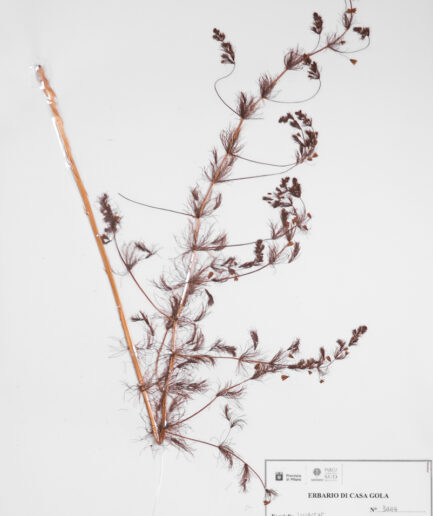Annual wall-rocket
Scientific Name: Diplotaxis muralis (L.) DC
Family: Brassicaceae
MORPHOLOGY
Habit and Size: Annual or biennial herbaceous plant, 30-50 cm tall, with a characteristic arugula flavor due to the presence of isothiocyanates.
Stems: Ascending or sub-erect stem, sometimes reddish, covered with spreading hairs in the first half and becoming glabrous towards the apex.
Leaves: Basal leaves in a rosette, pinnately divided or lobed-toothed (2-9 x 1-3 cm) with 2 – 6 pairs of oblong or ovate lateral segments, entire or toothed, and the terminal one with scattered and spreading hairs; the cauline leaves, only occasionally abundant, are smaller, almost sessile, and with a narrower blade.
Flowers: Inflorescence on sparse racemes with flowers on peduncles of 5 – 6 mm. Green sepals 4.5-5.5 mm ± glabrous and keeled. Tetramerous corolla with lemon-yellow petals, obovate-spatulate in shape (2.5 x 6) or (3.4 x 6-8 mm). At the end of flowering, it turns towards violet. Blooms from February to November.
Fruits and Seeds: The fruit is a silique of 2 x 20-40 mm, erect and parallel to the stem with a 1 cm peduncle; nearly absent carpophore: 0.2-0.6 mm. Seeds arranged in 2 rows and oval or ellipsoidal in shape (1-1.3 x 0.6-0.9 mm).
DISTRIBUTION AND HABITAT
Present throughout Italy except Sardinia and Calabria. It grows in meadows, cultivated fields, vineyards, pathsides, and ruins from sea level to 1000 m.
USE
In folk medicine, a juice rich in glucosinolates is obtained from the fresh or dried plant, excluding the root, which, when used as a syrup, has diuretic, expectorant, astringent, and antiscorbutic properties. Before taking any plant-based product (medicinal or non-medicinal) for therapeutic or similar purposes, it is always advisable to consult your doctor. Young leaves are used to flavor salads.
INTERESTING FACTS
Dioscorides, Pliny, and Ovid assured that it was an excellent aphrodisiac. For this reason, it was forbidden to cultivate it in monastery gardens.
Photo: Under a free license by Saxifraga, Ed Stikvoort, Jan van der Straaten, Rutger Barendse.





















